
The Forest Park CTA terminal in June 1959. CA&E had stopped running here nearly two years earlier, which facilitated expressway construction (it opened here in 1960). If CA&E had resumed it would have used the track and platform at the left of the CTA property, begging the question of why a temporary track wasn’t instead built using one of the nearby CGW tracks.
In the second of two posts, our last for this year, we again feature highlights from our recent E-book collection, The “New Look” in Chicago Transit: 1938-1973. Today’s highlights are from the CTA Transit News and mainly cover the period 1958-61. You will find the first installment here.
There is a tremendous amount of useful information in the Transit News, and there are thousands of pages of material on this DVD data disc we are offering.
FYI, all current orders for The “New Look” have now shipped.
The “New Look” in Chicago Transit: 1938-1973
Edited by David Sadowski
Over a period of 35 years, between 1938 and 1973, Chicago’s transit system was radically transformed, for better or for worse.
This transformation included the creation of the Chicago Transit Authority in 1945 by act of the state legislature. CTA represented public ownership and unification of Chicago’s mass transit system. The Chicago Rapid Transit Company, Chicago Surface Lines, and (later) Chicago Motor Coach Company were all merged.
The venerable Loop “L” was supplemented by two new subways, under State and Dearborn streets. Several “L” lines and dozens of stations were abandoned. New rapid transit lines were built in three different expressways.
Streetcars and trolley buses were eliminated, as were many grade crossings. Two of Chicago’s three major interurbans expired.
High-speed rapid transit cars were developed by the Chicago Transit Authority, and put into use on the new Skokie Swift service and, eventually, throughout the system. Air conditioning became standard on rapid transit cars.
By the early 1960s, the CTA began calling it a “New Look” in transit.
Now, to examine this transformation, we have collected many original CTA source documents from this revolution together in one place, as our third DVD data disc release, The “New Look” in Chicago Transit: 1938-1973, edited by David Sadowski.
Since our previous release Chicago’s PCC Streetcars: The Rest of the Story covered surface system changes, this new collection’s primary focus is rapid transit. Naturally, there is some overlap between the two E-books, but The “New Look” includes over 1000 pages of new material, including:
An introductory essay by transit historian David Sadowski, which puts the era into perspective
Special commemorative publications put out by the City of Chicago in 1943 and 1951, when the State Street and Dearborn subways opened
43 entire issues of CTA Transit News in hi-res (an employee publication, primarily covering the important transition period from 1958 through 1961), plus additional scans from 1964-65, 1967-68, and 1969-70
High-resolution scans of the 1958 and 1961 CTA Annual Reports (all reports from 1945-76 are also included in lower-res scans)
Rapid transit system track maps
A short book, The Story of the Chicago Rapid Transit Lines (circa 1938)
Numerous CTA pamphlets, covering A/B “skip stop” service, Rider’s Reader, opening of the Congress rapid transit line, “New Look” (aka “Fishbowl”) buses, bus overhaul shops, and the elevation of the outer end of the Lake Street “L”.
In addition, we have included a variety of CTA technical publications, including the operation of various old interlockings, signal systems, and troubleshooting manuals for the 4000-series rapid transit cars.
# of Discs – 1
Price: $19.95
Help Support The Trolley Dodger
This is our 108th post this year, and we are gradually creating a body of work and an online resource for the benefit of all railfans, everywhere. To date, we have received over 107,500 page views from 30,500 individuals.
You can help us continue our original transit research by checking out the fine products in our Online Store. You can make a donation there as well.
As we have said before, “If you buy here, we will be here.”
We thank you for your support.
PS- As we approach our one-year anniversary next month, the deadline for renewing our premium WordPress account comes due in less than 30 days. This includes out Internet domain www.thetrolleydodger.com, much of the storage space we use for the thousands of files posted here, and helps keep this an ads-free experience for our readers. Your contributions towards this goal are greatly appreciated, in any amount.
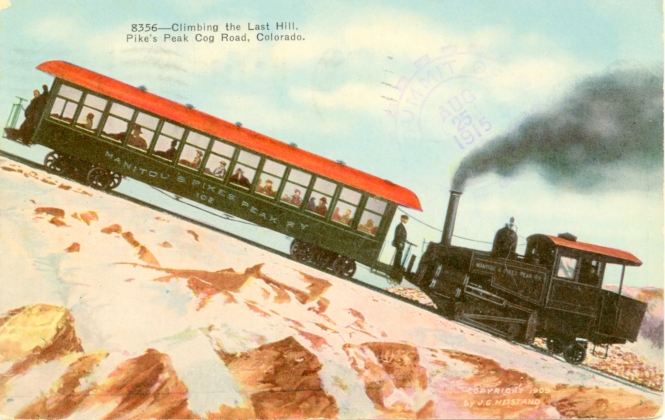
It’s an uphill climb, keeping this thing going. But we can do it with your help.
Space- The Final Frontier
One of our readers writes:
None of the pictures on this ‘thread’ are enlargeable, with the sole exception of the cover graphic piece. I don’t think it’s my PC as all the others readily enlarge.
We’ve just about run out of our 13 GB allotment of storage space for images. As a short-term fix, I started another free WordPress blog, which gives us an additional 3 GB. However, it seems that as a result, the pictures are not enlargeable.
This may be because they are links that are not pointed to the storage space for this blog, even though it’s just another WordPress blog. I’ll have to find out if there is a way to get around this issue, at least until more funds are available and we can purchase additional storage space from WordPress, thanks. Your contributions will help solve this issue, and we appreciate them.
2015 In Review
This blog started on January 21, 2015. During the year, we made 108 posts, which included a few thousand high quality images. For our first 107 posts, we have reached more than 107,000 page views, and average of more than 1000 per post, and this figure is gradually increasing.
This means that over time, we are building up a following. More people are looking at the new posts, and more people are in turn looking at the old posts. We welcome all of our visitors as guests to our virtual home and thank you for stopping by.
We also released nearly 30 new products, three important Ebook collections, and more than two dozen CD collections featuring the sounds of vintage streetcars, interurbans, and steam engines.
For 2016, we hope to finally complete our efforts to make the entire Railroad Record Club catalog available once again. We also hope to issue new recordings in the spirit of the RRC. Watch this space for further details.
1957 SF Muni PCC Leasing
FYI, we recently came across an interesting 1957 document from San Francisco’s Municipal Railway (Muni). The last new PCC streetcar built in America was made for Muni in 1952 (car #1040, and they still have it).
Anyhow, five years later they wanted to lease PCCs from other cities that still had them and no longer wanted them. While I know they eventually bought PCCs from other cities, I do not know whether they did on fact lease any.
However, the document is interesting because it specifies what Muni wanted in a standard PCC car. They had to be postwar cars and meet certain specifications made by the Transit Research Corporation. (TRC was the successor to the ERPCC, the Electric Railway Presidents’ Conference Committee, holder of the various PCC patents.)
This was the period where the CTA was finishing up dismantling the Chicago streetcar system. While 570 of the 600 postwar Chicago PCCs were scrapped for parts recycling, there were about two dozen cars that CTA tried to sell at the end of service.
A middleman purchased nearly all of them, with the idea of selling them to another city, such as Mexico City. Ultimately, no other city could be found that could use them, because they had non-standard dimensions.
Chicago had what you might call “Super PCCs.” These were longer than standard cars, had a unique third set of rear doors, and were designed for two-man operation, although some were eventually converted to one-man operation.
Although in the short run, this made it harder to sell the cars to another city, it was a prescient design. Since the 1950s, there has been a trend towards longer and longer streetcars, and the Flexitys now being delivered to Toronto dwarf even the Super PCCs that Chicago had.
We have added this 1957 document to our E-book collection Chicago’s PCC Streetcars: The Rest of the Story, available through our Online Store.
You can read it here.
Happy New Year! See you in 2016.
-David Sadowski


CTA found creative ways for recycling many of the wooden “L” cars that were retired in the 1950s. A few dozen of such cars were lined up at Skokie Shops and used for storage, until a new building was built on the property.

This Transit News article offers a logical explanation of why the 51st-55th trolley bus route was converted to motor buses in 1959, almost exactly one year after the last streetcar ran in Chicago. The City turned part of a street over to developers, and rather than reroute the trolley bus line, which would have involved an expense, CTA at first wanted to cut service back. They soon decided it would be better to separate 51st and 55th into two separate motor bus routes instead.
Similar considerations were involved previously when route 4 Cottage Grove streetcar line was converted to bus in 1955. For a while, Cottage Grove PCCs ran through a no man’s land of a street closed off to car traffic, where all nearby buildings had been torn down. The City Council granted this operation reprieves six months at a time until abandonment.
Similarly, the timing of bus conversion on route 49 – Western was influenced by the City’s desire to build a flyover on Western at Belmont, near Riverview.
If the CTA had been committed to electric surface transit, of course, they would have found a way to make these investments. Instead, all three examples were part of a gradual phase-out.

It’s unthinkable today, of course, to simply burn rail vehicles as a means of disposing of them, but air pollution was not such a concern in 1959 when this picture was taken. Neither was historic preservation—on some occasions railfans threw the matches and started the fires.

To this day, CTA trains on the Forest Park branch of the Blue Line use this bridge to cross over DesPlaines Avenue. But when the bridge was built, there was a crossing at grade behind the bridge. Typically, expressway bridges were dug out and built first, and the rest of the highway followed.

In 1959, CTA had fanciful ideas of operating a multiple unit bus train, and in fact there were other experiments with these concepts on the east coast that did not pan out. The Red Arrow Lines hoped such a vehicle would allow them to operate buses over tracks where their franchise required rail. Perhaps CTA hoped to operate such a service in the median of the Stevenson expressway, which never did receive a transit line.

Another view of that 1959 wooden “L” car bonfire.

These terminal facilities, primitive by today’s standards, remained in use until the present DesPlaines Blue Line terminal was built in the 1980s.
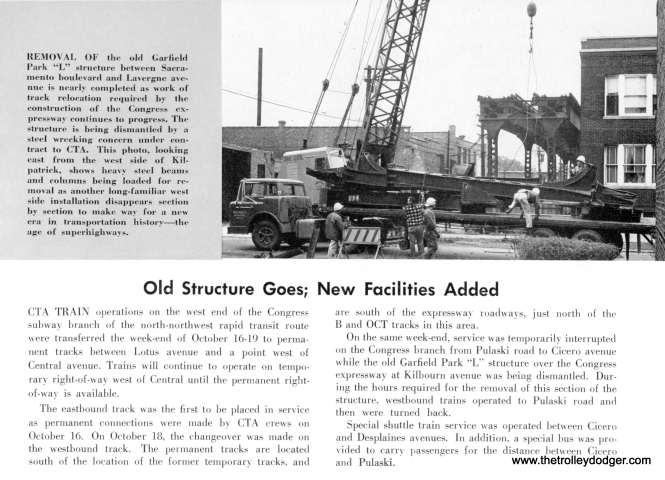
Throughout 1959, the old Garfield Park “L” structure was gradually being dismantled. This picture dates to around October. Meanwhile, the CTA finished working on the Congress line as far west as Central. This means that any connections that still remained with the old Laramie Yard were cut, which was necessary for the extension of the expressway at this point. Such tracks would have crossed the highway. If not for the DesPlaines terminal, an expensive permanent track connection, either via a subway or flyover, would have been needed between the Congress line and Laramie Yard.

The view looking east from about 612 S. Kilpatrick today. If the location in the previous picture is correct, it looks like the old Garfield Park “L” structure occupied the space just to the right of the alley.

Use of concrete support columns here foreshadowed their later use for other latter-day CTA “L”s.

Work on elevating the outer portion of Lake, planned for several years, got underway early in 1960.

These experimental high-speed rapid transit cars were termed “circus wagons” by the fans, but they eventually formed the backbone of service on the Skokie Swift for many years and paved the way for the various series of cars that have followed.

This is one of the very first CTA trains to use the permanent routing into the DesPlaines terminal on March 20, 1960. This bridge, originally designed for three tracks, is still in use. But with expressway construction far from finished, note the grade crossing right behind the bridge. That implies that the bridge was built first and then the area around it was later cleared out for the highway. Cars today go underneath the “L”. Behind the train, you can see a handsome 1939 field house, still in use today in a nearby park.

The temporary tracks veered off to the left at this point and seem to have continued at ground level. Meanwhile, the structures that carry the B&OCT over the CTA are at rear. Previously the two lines crossed at grade.
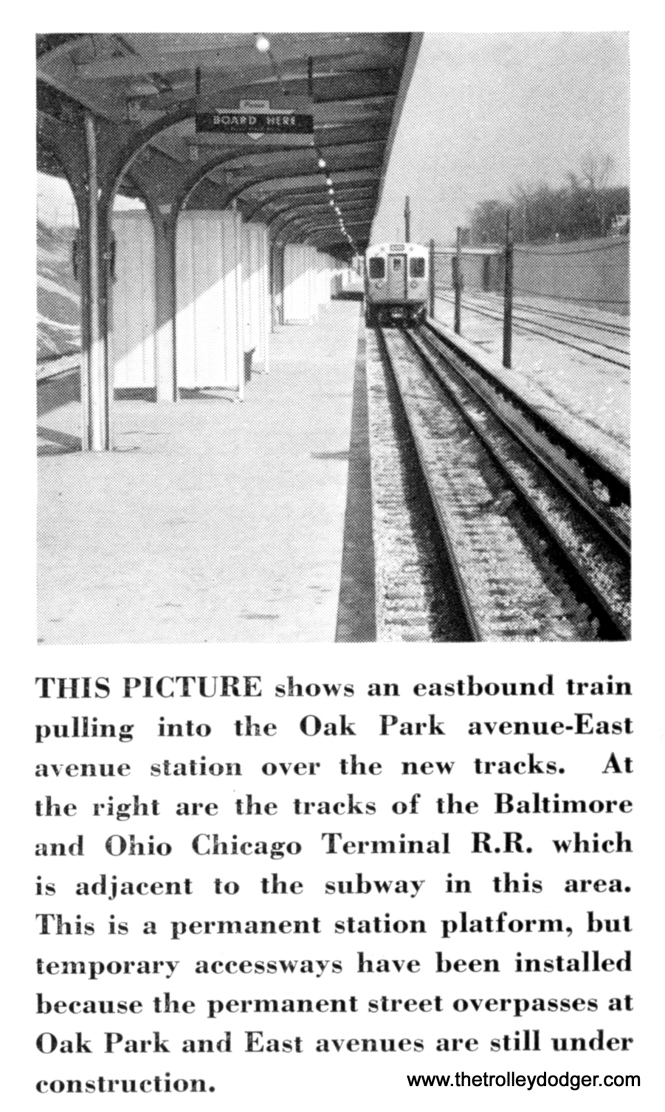

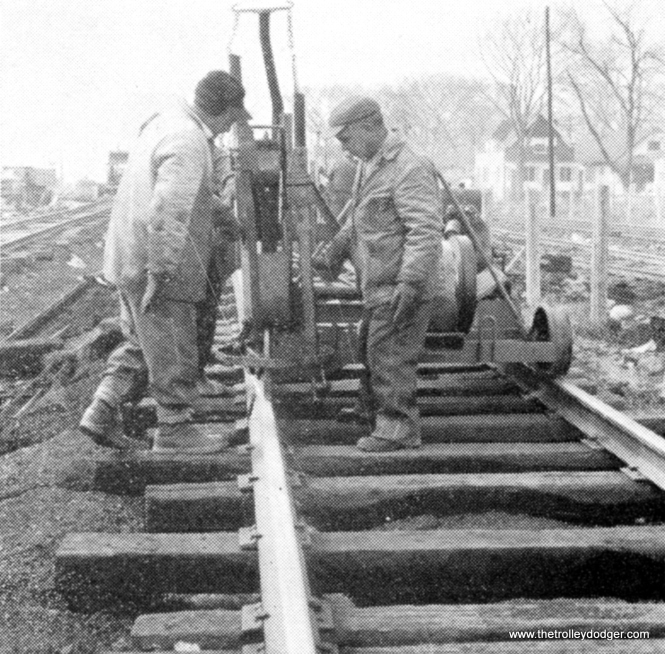
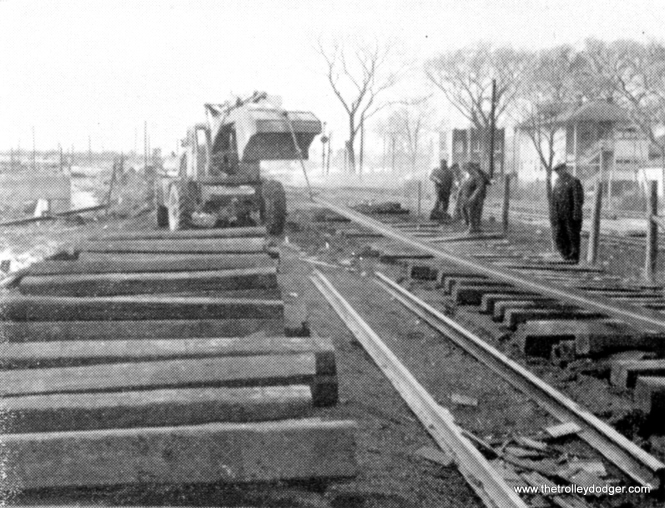
Removing the old temporary CTA tracks.


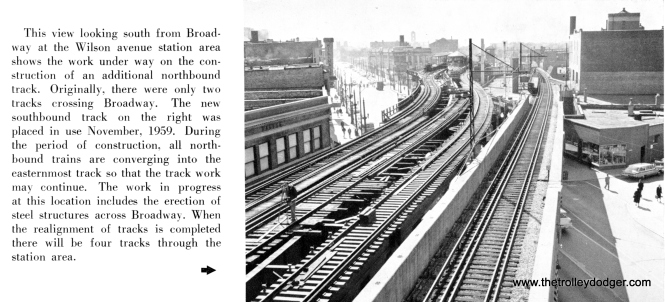
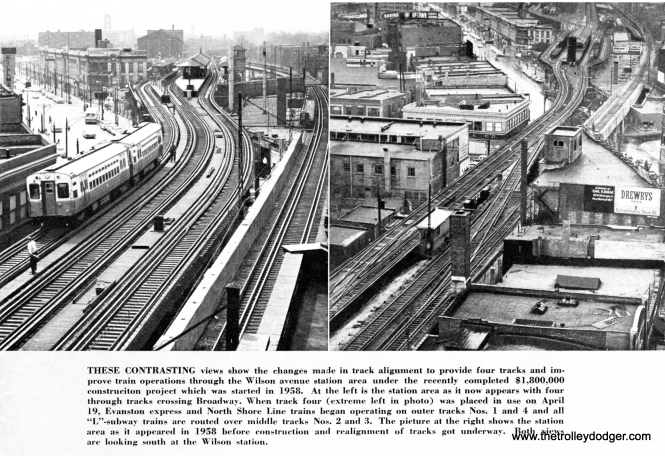
The CTA completed its project to have four tracks through the Wilson area around April, 1961.


What this blurb does not answer is why a two-block section of the old Humboldt Park “L” was even kept at all after the branch line was abandoned in the early 1950s. Rumor has it that a portion was kept in case it could be used for mid-day storage of trains from the Chicago, Aurora & Elgin in case it had resumed service. In that event, CA&E steel cars would have operated through the subway and deadheaded to North Avenue and storage tracks on this small portion of Humboldt. Alas, it was not to be. This picture was taken around September 1961, by which time the interurban was liquidating. By the following month, the Humboldt remnant was gone too.
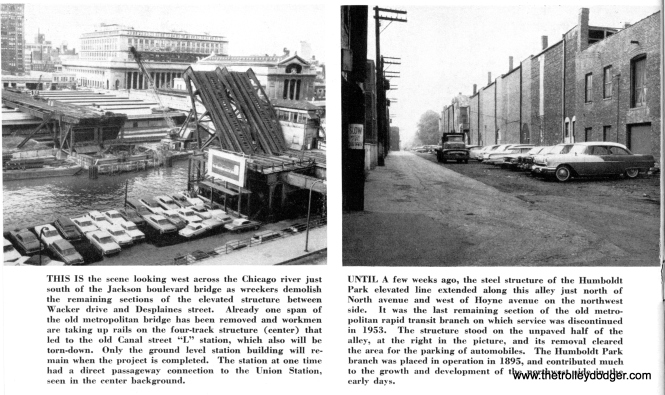
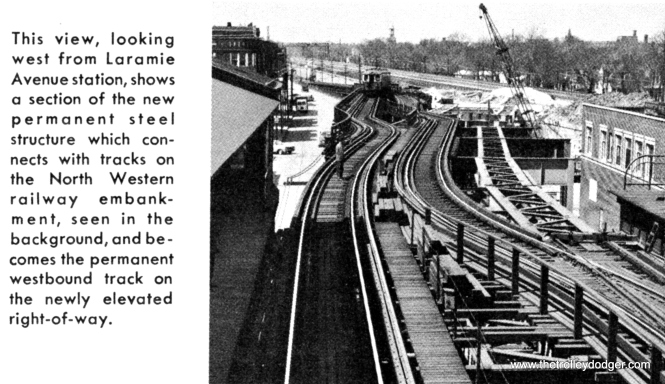
During the 1960-62 work to put the west end of Lake onto the C&NW embankment, we have a transitional view, showing the new ramp onto the embankment at right, and the reworked ramp down to street level at left.



Note that if one looks to the left in the shot of new Oak park Av station, excavating for the expressway hasn’t even started! Basically the way it was staged was that the CTA and B&OCT parts were finished completely before the expressway part was dug up, even the bridges across the highway were not there when the new L opened, and all the stations west of Laramie were at first more or less temporary deals. I believe Oak Park was the only one with its “real” platform. Harlem definitely was a wooden platform east of the street, and Austin apparently was also, with access from temporary control areas in all cases. Central wasn’t even on its final right of way at first.
Also, the first photo, of Desplaines Av, shows a very intermediate state. The turnback loop was thru the yard, using the outer track, and separate inbound and outbound platforms are in use. What was to be the permanent “temporary” station stubs off at the north end, and appears to have no canopy, and what will be the inbound track eventually is currently connected to the outbound track of the “loop in loop” layout, with the WB station track and what will be the turning loop both used for car storage. There were apparently many,many photos taken by CTA and the state of this project, and very few have ever shown up until recently.
One of the temporary stations (was it Harlem) was apparently built right on top of a crossover. Looks like they built the overpass bridges one half at a time.
When they cut over to the permanent tracks near DesPlaines, all the temp tracks were at ground level. They must have been able to work pretty fast, however, since I am pretty sure the highway in this area opened in 1960.
Thank you for another enjoyable post.
In the section regarding San Francisco Muni leasing PCCs you state “While I know they eventually bought PCCs from other cities, I do not know whether they did on fact lease any.” The 70 PCC cars acquired by Muni were by means of a lease-agreement with St. Louis Public Service. Ironically these cars only sat 53 rather than the 54 specified in the specification (“Inside Muni” by John McCane and Anthony Perles, page 40). I had never thought of Muni acquiring the stored Chicago cars, which would have likely met the requirements and San Francisco’s cars were also nine-feet wide while the double ended “Torpedoes” were 50.5-feet long; however the unusual hand controls used in Chicago may have been the deciding factor. The first 66 (1101-1166) cars were leased in 1957 but the last four cars (1167-1170) were not acquired until 1962. Ironically “Inside Muni” states the first 66 cars were “fitted with back-up controls from scrapped Chicago Transit Authority PCC cars by St. Louis Public Service before shipping to San Francisco” which must have been rendered surplus during the “conversion” to rapid transit cars by the St. Louis Car Company.
The San Diego vintage trolley line uses one of these St. Louis/San Francisco cars and the Western Railway Museum has one on display along with the restored car Muni 1016 which was the first car of the last order of PCCs to be built in North America which concluded with car 1040 which currently runs on the F-Market line in San Francisco.
Glad you enjoyed this post.
Sounds like perhaps St. Louis Car Company tried to sell some of the spare parts from the 570 scrapped Chicago PCCs. That only stands to reason, since I am sure there were many things that simply weren’t needed in a rapid transit car. Who knows where some of these parts may have ended up?
Thanks.